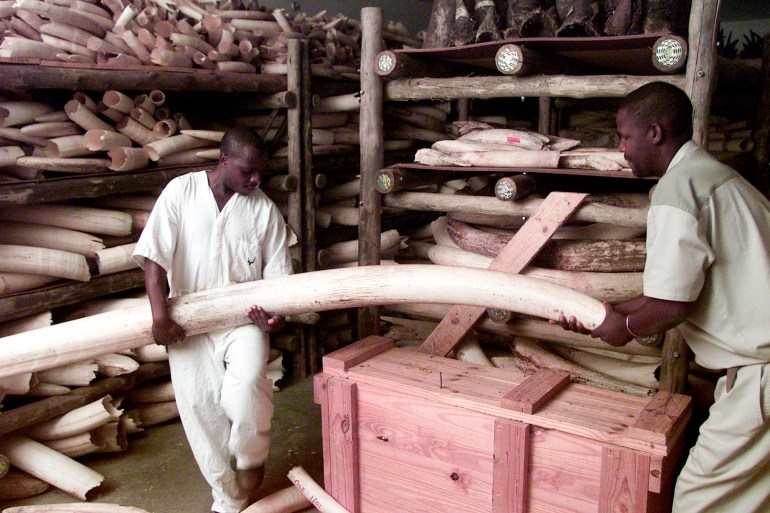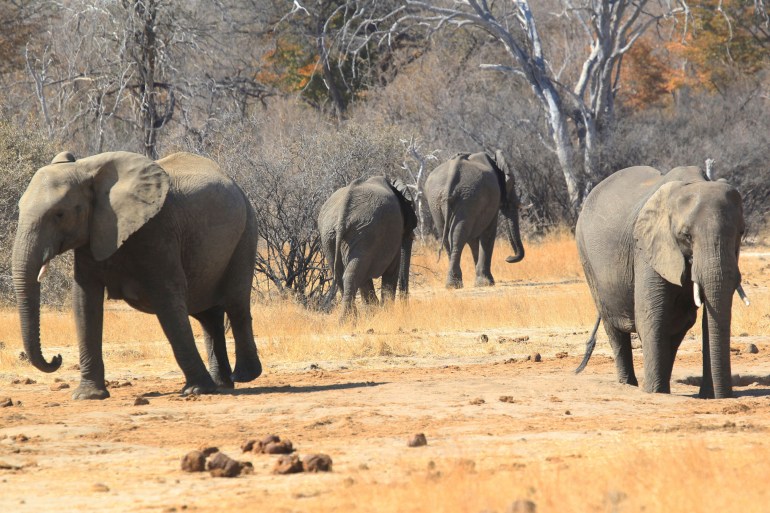They might be an awesome sight to see from a safe distance on safari as they lumber around with their big, lopping ears and long trunks, but for those who live side by side with elephants, these mammals can quickly become a menace.
Elephants’ numbers in African countries have dwindled hugely in the past. Conservation efforts since the 1980s, however, have seen populations recover somewhat. In Southern African countries, where about half of the African elephant population resides, their higher numbers mean they are starting to come into conflict with humans.
As a result, some of these countries have tried to reduce their elephant numbers. In Botswana, which has the largest number of elephants in the world, President Mokgweetsi Masisi has sought to push controversial policies, like the promotion of hunting by rich tourists. Last month, he lashed out at the German government for considering a ban on the import of elephant parts, threatening to send Berlin 20,000 of its jumbos.
The diplomatic spat made catchy headlines. But it belied the serious challenges facing elephants, rural communities and conservationists working to find solutions.

How have elephant numbers changed in the past?
Following long periods of overhunting and poaching for their meat and expensive ivory tusks, elephant numbers collapsed dramatically across Africa between the 1970s and 80s. About 100,000 elephants were killed each year during that time, according to the World Wildlife Fund (WWF). While an estimated three to five million elephants roamed the continent around 1930, the number had fallen to 1.3 million in 1979, the WWF says. According to researchers who have looked back as far as the 1500s, elephant populations in Africa have shrunk by some 98 percent.
Numbers continued to fall from 1979 until conservation practices – including crucial bans on sales of elephant parts and trophy hunting – halted the decline. Total elephant numbers in Africa currently stand at about 415,000, according to WWF estimates.
This is still low compared with historical numbers. In particular, the International Union for Conservation of Nature (IUCN) lists the African bush elephant as endangered and the African forest elephant as critically endangered, meaning they still face the threat of extinction.
The African bush elephant is a bigger animal inhabiting the savannah grasslands of Southern and Eastern Africa, making up 70 percent of the total population on the continent. Its cousin – the African forest elephant – is native to Western and Central Africa and is recognisable by its smaller, rounded ears and short, pointed tusks.
Botswana, Namibia, Angola, Zambia and Zimbabwe together account for more than half of the African bush elephant population. Botswana alone is home to about 130,000 bush elephants – about half of the region’s numbers. It is a big country with a small population of two million people, comparable in size to France, which has a population of 67 million. For every 15 people in Botswana, there is about one elephant.
Zimbabwe has the second-largest bush elephant population at about 100,000.

Why have rising numbers of elephants become a challenge?
The largest living land animals’ feeding habits can dramatically alter ecosystems during their roughly 60 years of life. They have few natural predators to manage their numbers besides humans and, with people out of the way, elephants can populate quickly, says researcher Lucy King from the non-profit organisation, Save the Elephants.
“When left alone, they breed pretty well [and] their numbers can go up quite steadily over time because their survival rate is pretty good,” King says.
During the same time that elephant numbers have steadied, human population growth has doubled across Africa. In Southern and Eastern Africa, the population grew from 312 million in 1994 to 633 million in 2021 according to the United Nations Population Fund. That growth has seen humans occupy more land area and increasingly encroach on wildlife habitats. Settlements and farms have also cut roaming wildlife off from water or food sources.
As a result, humans and elephants are coming into more frequent contact and are clashing over the same resources. Foraging herbivores often roam onto farms, rip open thatch roofs on huts in search of food or cause damage to water pipes and other infrastructure. This has prompted angry locals to retaliate and attack them. Those interactions can be fatal for both man and beast.
Climate change has also caused more elephants to wander further than they once would have – and to more unpredictable places – to seek scarce food and water.
Zimbabwe is a peak conflict site, but human-elephant clashes are increasingly occurring across the region, King says.
Countries like Zimbabwe and Botswana blame elephant overpopulation and argue that reducing their numbers would reduce these clashes. However, some experts reject this suggestion, pointing out that there used to be many more elephants in Africa.
How have governments tried to tackle the issue?
South Africa, Namibia, Zimbabwe and Botswana have all tried to reduce the number of elephants in their territory at certain points, but nearly all their methods have been met with criticism or outright condemnation from animal welfare organisations.
One practice is culling – the deliberate targeting and killing of several animals, usually whole families, together.
This practice was popular around the 1980s and 90s. In South Africa’s Kruger Park, a culling campaign saw about 14,000 elephants killed between 1967 and 1995. However, the practice was outlawed after African countries faced a global backlash, such as widespread calls for tourists to boycott countries culling elephants.
However, in 2008, South Africa defied the global outcry and lifted its culling ban. In 2021, Zimbabwe – which had killed about 50,000 elephants between 1967 and 1988 – said it was considering bringing back the practice.
Conservationists such as King argue that culling is particularly cruel for elephants, who are emotionally intelligent and can experience trauma. Besides, the method is not effective and will “hardly scratch the surface”, she says.
Governments have also attempted to simply sell off part of their herds, although animal welfare groups say elephants could be shipped to zoos and used for human entertainment.
In 2021, Namibia auctioned 170 elephants but sold only a third – at 5.9 million Namibian dollars ($400,000). There was so much bad press and criticism of the sale that buyers were discouraged, officials said.
Another way to control numbers is by allowing trophy hunting, whereby countries license adventure seekers – usually tourists from the United States and other Western countries – to kill a limited number of animals in specific, allocated areas for their horns, skins and tusks. Often, these tourists target male elephants – or bulls – for their bigger tusks.
Government officials in Southern Africa – and hunters themselves – argue that hunting helps manage the elephant population naturally and provides revenue for local communities. That in turn incentivises local communities to stop illegal poaching and to ensure that elephant numbers remain steady — and never drop below a sustainable level. Hunting licences can cost as much as $10,000, depending on the animal being hunted.
African governments are often angered by the idea of Western countries telling them the practice is unethical – hence the threat by Botswana to ship 20,000 elephants to Germany. Botswana’s President Masisi has been a particular advocate for the return of hunting licences. In 2019, after he took office, Botswana lifted a five-year ban on elephant hunting.
What are the arguments against hunting?
Some conservationists dismiss this anger from African governments.
“I just think it’s extremely shortsighted. I think it’s a convenient smokescreen behind which to hide and justify trophy hunting which is big business,” says Ross Harvey, a wildlife economist with the non-profit organisation Good Governance Africa. Harvey points out that much of the funds from trophy hunting – first introduced in colonial Kenya – go to wealthy businessmen who own trophy hunting companies, rather than into conservation efforts.
“How much of it actually ends up going to conservation is highly questionable, certainly not enough to conserve the landscape, and how much of it accrues to poor community members is also extremely unclear,” he adds. “But now that elephant is gone, now you live with the negative effects of having taken out all the bulls – typically in their reproductive peak.”
Older males often help guide younger bulls, teaching them where to find food and water, or how to behave. When they are killed, younger males can become aggressive, researchers have found.
“My prediction is that you’re going to see an increase in human and elephant conflict because when you take out all the bulls that are responsible for disciplining the herd, then crop raiding is going to increase, not decrease,” says Harvey.
So, what is the solution?
Harvey says while elephant numbers may have increased since the 1990s, the real problem is not one of “overpopulation” but rather of humans cutting off connecting land strips or corridors which elephants – and all wildlife – use to migrate in search of food and habitat. Freeing up those spaces, he argues, will reduce human-elephant interactions.
“If you shoot them, you just exacerbate the problem,” he says.
“There’s only two solutions really,” says King. “One, to have breathing space. We keep throwing up fences everywhere and stopping [elephants], so they get squeezed into areas where they can then deplete the vegetation incredibly fast. The only solution is to release the valves and make sure the fences come down. That does not mean that elephants should be everywhere … but you can’t fence elephants in.”
In northern Botswana, one initiative called the “Eco-Exist Project” worked with locals to identify and demarcate more than 60 elephant corridors across the sprawling Okavango Delta. The team then worked with communities to replan village layouts, so that farms, homes and other infrastructure would be positioned away from these “elephant highways”.
It is not yet clear how much this project has reduced human-elephant conflict, but some 65,000 hectares (160,600 acres) of farmland belonging to 500 farmers, have been protected so far. Farmers have also clustered to share farm spaces which they have ringed with fences or crops such as chilli – which elephants dislike and therefore avoid.
Another solution, King says, is to teach people how to live more harmoniously with the animals. Her research on natural ways to fend off elephants from settlements and farms in southern Kenya has yielded some results.
King found that when she played sound recordings of swarming bees, elephants would disperse in a hurry. She then started to experiment with building beehive fences around several farmsteads. This is a rudimentary method which is suitable for rural communities – farmers need only poles to mount boxes housing the hives. Women then harvest the honey and sell it for some side income. The method is now being employed in 17 African countries and some areas in Asia.
“We’re really proud about it … and it’s completely open source,” King says. “We let people have the manuals, develop their own bio fence project, and run with it. And the interesting thing is it’s really working everywhere.”
However, the method works for small land areas only. It is also threatened by drought – which is not conducive for bees.

